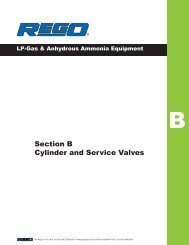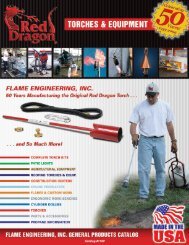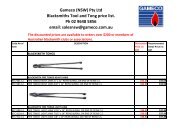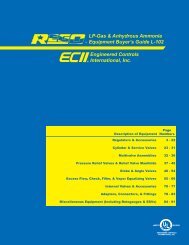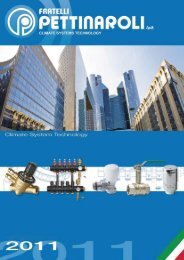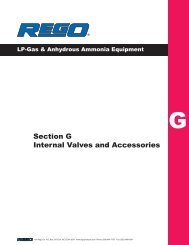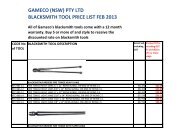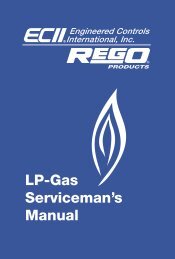Repair Kits Available By Part Number Section 2 Page - GAMECO
Repair Kits Available By Part Number Section 2 Page - GAMECO
Repair Kits Available By Part Number Section 2 Page - GAMECO
You also want an ePaper? Increase the reach of your titles
YUMPU automatically turns print PDFs into web optimized ePapers that Google loves.
WARNING: Installation, usage and maintenance of this product<br />
must be in compliance with all Engineered Controls International,<br />
Inc. instructions as well as requirements and provisions of NFPA<br />
#54, NFPA #58, DOT, ANSI, all applicable federal, state, provincial<br />
and local standards, codes, regulations and laws.<br />
Inspection and maintenance on a periodic basis is essential.<br />
Installation and maintenance should be performed only by qualified<br />
personnel.<br />
Be sure all instructions are read and understood before installation,<br />
operation and maintenance. These instructions must be<br />
passed along to the end user of the product.<br />
CAUTION: Contact or inhalation of liquid propane, ammonia and<br />
their vapors can cause serious injury or death! NH3 and LP-Gas<br />
must be released outdoors in air currents that will insure dispersion<br />
to prevent exposure to people and livestock. LP-Gas must be kept<br />
far enough from any open flame or other source of ignition to<br />
prevent fire or explosion! LP-Gas is heavier than air and will not<br />
disperse or evaporate rapidly if released in still air.<br />
Operation<br />
The 7606RT Remote Thermal Cable Kit is used with ECII ® Emergency<br />
Shut-Off Valves (ESVs) to provide automatic temperature actuated<br />
shutdown from a remote location. They are needed to comply with<br />
NFPA #58 requirements when the Emergency Shut-Off Valve is installed<br />
more than five feet from the nearest end of the hose or swivel type piping<br />
connected to the line in which the valve is installed.<br />
Other applications include automatic temperature actuated shutdown<br />
of Emergency Shut-Off Valves used to shut off flow in event of fire in<br />
vaporizer, cylinder filling, or motor fuel dispenser applications.<br />
Installation<br />
1. Make a sketch of bulkhead area. Determine desired location for<br />
remote thermal release. It is best if cable (50 ft. maximum length) can<br />
be run in a straight line parallel to axis of ESV, as shown in Figure 1,<br />
directly to remote thermal release. If change in direction is required,<br />
see Figure 2.<br />
2. Install 1" pipe terminal post (G) or other suitable mounting means at<br />
desired location for remote thermal release. Install 1" pipe support<br />
posts (H) with 1" tees as needed, approximately 15 feet apart along<br />
cable line.<br />
3. Install 1" coupling on top of terminal post and mount thermal release<br />
assembly, with fuse link end facing directly towards where the cable<br />
will run.<br />
4. Attach cable (D) to end of chain, (C) with use of sleeve loop. Attach<br />
other end of cable to forward release lever of ESV (E) with a sleeve<br />
loop, adjusting cable length tight enough to eliminate excessive<br />
slack, but loose enough to prevent premature closing of ESV.<br />
7606RT Remote Thermal<br />
Cable Kit Installation Manual<br />
NOTE: For long runs, or if a change of direction in control line is needed,<br />
install <strong>Part</strong> 7606RM-1 Tension Spring to prevent premature closing of<br />
ESV. (Refer to ECII ® Instruction Sheet 7606RM-301 for the 7606RM<br />
Remote Manual ESV Cable Kit.)<br />
5. Test operation of completely assembled system to assure ESV will<br />
close properly when fuse link (B) actuates. This may be done by<br />
rotating ESV lever to open and latched position. Then pull carefully<br />
on chain (C) to stretch spring enough to remove fuse link (B) from end<br />
loop of spring. Relax pull on chain, allowing spring (A) to pull cable<br />
(D). ESV should close as cable (D) tightens. Repeat this several times<br />
to assure that ESV will close properly. Reinstall fuse link, pulling chain<br />
to stretch spring as needed.<br />
NOTE: If remote thermal release cable must turn a corner, use a 12"<br />
cable loop and terminal post as shown in Figure 2. The 12" cable loop<br />
will swing in an arc when thermal release spring pulls cable, applying<br />
tension to cable attached to ESV to close valve.<br />
Many variations from arrangements shown are possible. Apply the<br />
basic ideas shown in Figures 1 and 2 to meet individual needs. Please<br />
call us if you need advice.<br />
Hints for Installation<br />
1. Cut cables carefully and square for easy installation of cable clamps.<br />
2. Squeeze clamps tightly with vise-grip pliers or other tool to attach<br />
them securely to cable. Check each clamp to make sure it doesn’t<br />
slip.<br />
3. Don’t kink cables when handling. Unwind coils carefully. A kinked<br />
cable will act as a spring, making it difficult to properly adjust control<br />
systems.<br />
4. Squeeze each loop flat with fingers after clamping cables, to remove<br />
excessive spring action. This will make it easier to adjust the<br />
completed system and minimize later readjustment.<br />
5. Install the support posts accurately, in line with cable runs, to<br />
minimize friction and eliminate possible cable wear.<br />
6. Keep the entire cable installation above ground.<br />
7. Mount terminal post and all guide posts in concrete for a permanent,<br />
sturdy installation.<br />
NOTE: It is recommended that all ECII ® ESVs use <strong>Part</strong> 7609-50 Transfer<br />
Hose Cable Control as the first line of defense. Use it even for<br />
applications not incorporating a permanently attached hose, by attaching<br />
cable to truck end of breakaway fitting or piping.<br />
A B<br />
C<br />
D<br />
Figure 1 — Basic Control System<br />
The simple device uses a strong stainless steel tension spring (A) held<br />
in place by a heavy duty 212° Fuse link (B). A length of stainless steel<br />
aircraft cable (D) is installed between the forward release lever of the<br />
ECII ® ESV and the chain (C). When the fusible element melts, the spring<br />
is released, pulling the cable to close the ESV. The chain (C) is used to<br />
reset the spring when replacing the fuse link.<br />
50' Max.<br />
D<br />
E<br />
G<br />
H



